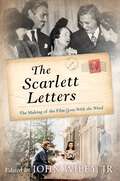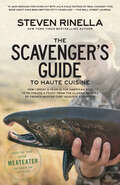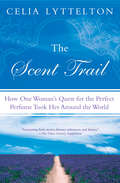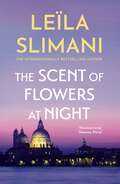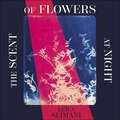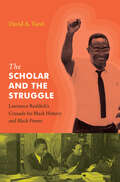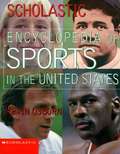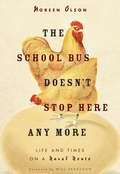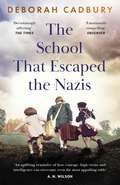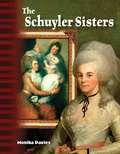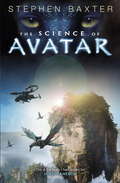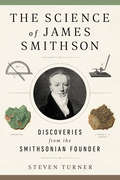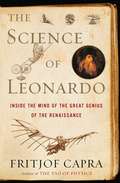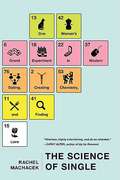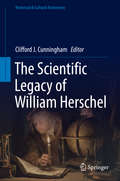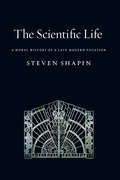- Table View
- List View
The Scarlett Letters: The Making of the Film Gone With the Wind
by John Wiley Jr.One month after her novel Gone With the Wind was published, Margaret Mitchell sold the movie rights for fifty thousand dollars. Fearful of what the studio might do to her story—&“I wouldn&’t put it beyond Hollywood to have . . . Scarlett seduce General Sherman,&” she joked—the author washed her hands of involvement with the film. However, driven by a maternal interest in her literary firstborn and compelled by her Southern manners to answer every fan letter she received, Mitchell was unable to stay aloof for long.In this collection of her letters about the 1939 motion picture classic, readers have a front-row seat as the author watches the Dream Factory at work, learning the ins and outs of filmmaking and discovering the peculiarities of a movie-crazed public. Her ability to weave a story, so evident in Gone With the Wind,makes for delightful reading in her correspondence with a who&’s who of Hollywood, from producer David O. Selznick, director George Cukor, and screenwriter Sidney Howard, to cast members Clark Gable, Vivien Leigh, Leslie Howard, Olivia de Havilland and Hattie McDaniel.Mitchell also wrote to thousands of others—aspiring actresses eager to play Scarlett O&’Hara; fellow Southerners hopeful of seeing their homes or their grandmother&’s dress used in the film; rabid movie fans determined that their favorite star be cast; and creators of songs, dolls and Scarlett panties who were convinced the author was their ticket to fame and fortune. During the film&’s production, she corrected erring journalists and the producer&’s over-the-top publicist who fed the gossip mills, accuracy be damned. Once the movie finished, she struggled to deal with friends and strangers alike who &“fought and trampled little children and connived and broke the ties of lifelong friendship&” to get tickets to the premiere.But through it all, she retained her sense of humor. Recounting an acquaintance&’s denial of the rumor that the author herself was going to play Scarlett, Mitchell noted he &“ungallantly stated that I was something like fifty years too old for the part.&” After receiving numerous letters and phone calls from the studio about Belle Watling&’s accent, the author related her father was &“convulsed at the idea of someone telephoning from New York to discover how the madam of a Confederate bordello talked.&” And in a chatty letter to Gable after the premiere, Mitchell coyly admitted being &“feminine enough to be quite charmed&” by his statement to the press that she was &“fascinating,&” but added: &“Even my best friends look at me in a speculative way—probably wondering what they overlooked that your sharp eyes saw!&” As Gone With the Wind marks its seventy-fifth anniversary on the silver screen, these letters, edited by Mitchell historian John Wiley, Jr., offer a fresh look at the most popular motion picture of all time through the eyes of the woman who gave birth to Scarlett.
The Scavenger's Guide to Haute Cuisine: How I Spent a Year in the American Wild to Re-create a Feast from the Classic Recipes of French Master Chef Auguste Escoffier
by Steven RinellaWhen outdoorsman, avid hunter, and nature writer Steven Rinella stumbles upon Auguste Escoffier's 1903 milestone Le Guide Culinaire, he's inspired to assemble an unusual feast: a forty-five-course meal born entirely of Escoffier's esoteric wild game recipes. Over the course of one unforgettable year, he steadily procures his ingredients--fishing for stingrays in Florida, hunting mountain goats in Alaska, flying to Michigan to obtain a fifteen-pound snapping turtle--and encountering one colorful character after another. And as he introduces his vegetarian girlfriend to a huntsman's lifestyle, Rinella must also come to terms with the loss of his lifelong mentor--his father. An absorbing account of one man's relationship with family, friends, food, and the natural world, The Scavenger's Guide to Haute Cuisine is a rollicking tale of the American wild and its spoils. Praise for The Scavenger's Guide to Haute Cuisine "If Jack Kerouac had hung out with Julia Child instead of Neal Cassady, this book might have been written fifty years ago. . . . Steven Rinella brings bohemian flair and flashes of poetic sensibility to his picaresque tale of a man, a cookbook, and the culinary open road."--The Wall Street Journal "If you rue the 'depersonalization of food production,' or you're tired of chemical ingredients, [Rinella] will make you howl."--Los Angeles Times "A walk on the wild side of hunting and gathering, sure to repel a few professional food sissies but attract many more with its sheer in-your-face energy and fine storytelling."--Jim Harrison, author of Legends of the Fall "[A] warped, wonderful memoir of cooking and eating . . . [Rinella] recounts these madcap wilderness adventures with delicious verve and charm."--Men's JournalFrom the Trade Paperback edition.
The Scent Trail: How One Woman's Quest for the Perfect Perfume Took Her Around the World
by Celia LytteltonA unique travel memoir, The Scent Trail charts a woman's journey as she explores the magic and history behind the ingredients of her own bespoke perfume.<P><P>When Celia Lyttelton visits a bespoke perfumer in London, she enters the heady and exotic world of scent. On a London backstreet she is transported to a world made up of thousands of oils, unguents and balms -- all hidden away in an old Chinese medicine chest.And so begins Celia's remarkable quest to discover the origin, history and culture of the many ingredients that make up her unique custom-made perfume. It is a quest that will take her from Tuscany to Morocco, from Sri Lanka to Tibet, from the peasants and farmers growing their own crops and the traders who sell to the perfume houses, to the "noses" who create the scents and the marketing kings involved in this billion dollar industry. As Celia explores the mythology, history and culture behind ingredients such as jasmine, nutmeg, musk and ambergris, she paints a vivid portrait of this mysterious, sensual world, conjuring up the people she has met and the places she has visited on her scent trail.
The Scent of Eucalyptus: Precious Poems
by Sophie ChenowethThis book is an ode to the fragrant, yet rough-hewn Australian bush. By delving into its pages, you will be transported to a parallel realm where flannel flowers sing, cockatoos choreograph and paperbark trees seduce. A memoir of sorts, this poignant and ethereal collection of poems celebrates the beauty, the harshness and the resilience of this ancient land and its unforgettable inhabitants. In addition, you'll be serenaded by harps and fairies, meander through time in a yellow dinghy and stand in quiet awe as a ballerina beguiles. Refreshingly honest, this waltz down memory lane is intensely emotional but has a lightness that will soothe even on the blusteriest of days. Illustrated with sensitively taken photographs, it is a keepsake you will cherish for many years to come.
The Scent of Flowers at Night: a stunning new work of non-fiction from the bestselling author of Lullaby
by Leïla Slimani'Night is the land of reinvention, whispered prayers, erotic passions. Night is the place where utopias have the scent of the possible, where we no longer feel constrained by petty reality. Night is the country of dreams where we discover that, in the secrecy of our heart, we are host to a multitude of voices and an infinity of worlds...'Over one night, alone in the Punta della Dogana Museum in Venice, Leïla Slimani grapples with the self as it is revealed in solitude. In a place of old and new, she confronts her past and her present, through her life as a Moroccan woman, as a writer, and as a daughter. Surrounded by art, she explores what it means to behold and clasp beauty; enveloped by night, she confronts the meaning of life and death.Translated from the French by Sam Taylor
The Scent of Flowers at Night: a stunning new work of non-fiction from the bestselling author of Lullaby
by Leïla Slimani'A revelation' KATY HESSEL'Brilliant' OBSERVEROver one night, alone in the Punta della Dogana Museum in Venice, Leïla Slimani grapples with the self as it is revealed in solitude. In a place of old and new, she confronts her past and her present, through her life as a Moroccan woman, as a writer, and as a daughter. Surrounded by art, she explores what it means to behold and clasp beauty; enveloped by night, she confronts the meaning of life and death.Translated from the French by Sam Taylor
The Scent of Flowers at Night: a stunning new work of non-fiction from the bestselling author of Lullaby
by Leïla Slimani'Night is the land of reinvention, whispered prayers, erotic passions. Night is the place where utopias have the scent of the possible, where we no longer feel constrained by petty reality. Night is the country of dreams where we discover that, in the secrecy of our heart, we are host to a multitude of voices and an infinity of worlds...'Over one night, alone in the Punta della Dogana Museum in Venice, Leïla Slimani grapples with the self as it is revealed in solitude. In a place of old and new, she confronts her past and her present, through her life as a Moroccan woman, as a writer, and as a daughter. Surrounded by art, she explores what it means to behold and clasp beauty; enveloped by night, she confronts the meaning of life and death.Translated from the French by Sam Taylor
The Scent of Snowflowers: A Chronicle of Faith, Hope and Survival in War-ravaged Budapest
by R. L. KleinThe true story of a Jewish family and the Gentiles who hid and protected them during World War II in Budapest.
The Scholar and the Struggle: Lawrence Reddick's Crusade for Black History and Black Power
by David A. VarelLawrence Reddick (1910–1995) was among the most notable African American intellectuals of his generation. The second curator of the Schomburg Library and a University of Chicago PhD, Reddick helped spearhead Carter Woodson's black history movement in the 1930s, guide the Double Victory campaign during World War II, lead the Southern Christian Leadership Conference during the Cold War, mentor Martin Luther King Jr. throughout his entire public life, direct the Opportunities Industrialization Center Institute during the 1960s, and forcefully confront institutional racism within academia during the Black Power era. A lifelong Pan-Africanist, Reddick also fought for decolonization and black self-determination alongside Kwame Nkrumah, Nnamdi Azikiwe, Leopold Senghor, and W. E. B. Du Bois. Beyond participating in such struggles, Reddick documented and interpreted them for black and white publics alike.In The Scholar and the Struggle, David A. Varel tells Reddick's compelling story. His biography reveals the many essential but underappreciated roles played by intellectuals in the black freedom struggle and connects the past to the present in powerful, unforgettable ways.
The Scholastic Encyclopedia of Sports in the United States
by Kevin OsbornThis volume explores the fascinating history of American sports, from being the Devil's pastime in Puritan New England to the celebrity-filled big business it is today. Readers will learn about many stars as well as less famous athletes, and the personal attributes of players that make them outstanding and influential people.
The Scholems: A Story of the German-Jewish Bourgeoisie from Emancipation to Destruction
by Jay Howard GellerThe evocative and riveting stories of four brothers—Gershom the Zionist, Werner the Communist, Reinhold the nationalist, and Erich the liberal—weave together in The Scholems, a biography of an eminent middle-class Jewish Berlin family and a social history of the Jews in Germany in the decades leading up to World War II.Across four generations, Jay Howard Geller illuminates the transformation of traditional Jews into modern German citizens, the challenges they faced, and the ways that they shaped the German-Jewish century, beginning with Prussia's emancipation of the Jews in 1812 and ending with exclusion and disenfranchisement under the Nazis. Focusing on the renowned philosopher and Kabbalah scholar Gershom Scholem and his family, their story beautifully draws out the rise and fall of bourgeois life in the unique subculture that was Jewish Berlin. Geller portrays the family within a much larger context of economic advancement, the adoption of German culture and debates on Jewish identity, struggles for integration into society, and varying political choices during the German Empire, World War I, the Weimar Republic, and the Nazi era. What Geller discovers, and unveils for the reader, is a fascinating portal through which to view the experience of the Jewish middle class in Germany.
The School
by Henry Viscardi Jr.The true story of a man who opened a K-12 school for children with physical disabilities in the early 1960s. Describes the accomplishments of the children, many of whom had seldom been out of their homes. The book also describes the opposition and discrimination the school's founders faced when the local residents decided they didn't want the school to be built in their neighborhood
The School Bus Doesn't Stop Here Anymore
by Will Ferguson Noreen OlsonWelcome to Noreen Olson's kitchen table, where everything happens. She loves birds, animals, family, children, friends, growing things and life on the farm, and writes about them and all the odd situations they manage to get into with engaging liveliness. Many of the pieces are humorous, but more than that, they are heartwarming and true. In them you will see reflections of your own loves, life, guilt, laughter, nostalgia, memories and beliefs.All of the animals, people and incidents are real (though Noreen admits that she is prone to the occasional slight exaggeration) and names have been changed for "her own protection". The titles of the short tales say it all: Saving the Preemie Calf, My Career As an Egg Grader, Lament for a Lousy Garden, Kitchen Archaeology, Embarrassing the Kids, The Lawn Ornament Vendetta and One More Way to Ruin a Party.Noreen Olson has been writing these true tales in her biweekly column for more than twenty-three years, and collected them in six books. These stories are the best of the best, together with newly written introductions to thematic groupings, and an introduction by Will Ferguson.
The School That Escaped the Nazis
by Deborah Cadbury'All the violence I had experienced before felt like a bad dream. It was a paradise. I think most of the children felt it was a paradise.'In 1933, as Hitler came to power, schoolteacher Anna Essinger hatched a daring and courageous plan: to smuggle her entire school out of Nazi Germany. Anna had read Mein Kampf and knew the terrible danger that Hitler's hate-fuelled ideologies posed to her pupils. She knew that to protect them she had to get her pupils to the safety of England. But the safe haven that Anna struggled to create in a rundown manor house in Kent would test her to the limit. As the news from Europe continued to darken, Anna rescued successive waves of fleeing children and, when war broke out, she and her pupils faced a second exodus. One by one countries fell to the Nazis and before long unspeakable rumours began to circulate. Red Cross messages stopped and parents in occupied Europe vanished. In time, Anna would take in orphans who had given up all hope; the survivors of unimaginable horrors. Anna's school offered these scarred children the love and security they needed to rebuild their lives, showing them that, despite everything, there was still a world worth fighting for.Featuring moving first-hand testimony, and drawn from letters, diaries and present-day interviews, The School That Escaped the Nazis is a dramatic human tale that offers a unique child's-eye perspective on Nazi persecution and the Holocaust. It is also the story of one woman's refusal to allow her beliefs in a better, more equitable world to be overtaken by the evil that surrounded her.
The School That Escaped the Nazis
by Deborah CadburyThe extraordinary true story of progressive schoolteacher, Anna Essinger, the woman who defied Hitler, smuggling her school and its pupils from Nazi Germany to the safety of England.'All the violence I had experienced before felt like a bad dream. It was a paradise. I think most of the children felt it was a paradise.'In 1933, as Hitler came to power, schoolteacher Anna Essinger hatched a daring and courageous plan: to smuggle her entire school out of Nazi Germany. Anna had read Mein Kampf and knew the terrible danger that Hitler's hate-fuelled ideologies posed to her pupils. She knew that to protect them she had to get her pupils to the safety of England. But the safe haven that Anna struggled to create in a rundown manor house in Kent would test her to the limit. As the news from Europe continued to darken, Anna rescued successive waves of fleeing children and, when war broke out, she and her pupils faced a second exodus. One by one countries fell to the Nazis and before long unspeakable rumours began to circulate. Red Cross messages stopped and parents in occupied Europe vanished. In time, Anna would take in orphans who had given up all hope; the survivors of unimaginable horrors. Anna's school offered these scarred children the love and security they needed to rebuild their lives, showing them that, despite everything, there was still a world worth fighting for.Featuring moving first-hand testimony, and drawn from letters, diaries and present-day interviews, The School That Escaped the Nazis is a dramatic human tale that offers a unique child's-eye perspective on Nazi persecution and the Holocaust. It is also the story of one woman's refusal to allow her beliefs in a better, more equitable world to be overtaken by the evil that surrounded her.(P) 2022 Hodder & Stoughton Limited
The Schoolmaster: A Commentary Upon the Aims and Methods of an Assistant-master in a Public School
by AC BensonThe Schoolmaster was originally published at the turn of the 20th century, when the world was a very different place, and yet Benson's strikingly honest words about his chosen profession are, in the main, still relevant today. Benson was born at Wellington College, educated at Eton and Cambridge and spent his life and career at both. He also had a very successful career outside of education; he was a prolific writer, the editor of Queen Victoria's letters, lyricist and prolific diary writer.
The Schuyler Sisters
by Monika DaviesIn The Schuyler Sisters, readers will learn about the fascinating lives of Eliza and Angelica Schuyler, their influence on Alexander Hamilton and United States history, and the roles of women in the 1700s-1800s. Through the use of dynamic primary sources like maps and letters, middle school students will be engaged as they read about history and build their literacy skills. Supporting today's social studies standards, this full-color text includes intriguing images, interesting sidebars, a glossary, and other important text features to support learning and strengthen key comprehension skills.
The Science of Avatar
by Stephen BaxterJames Cameron's Avatar is the biggest movie of all time. Now the movie's legendary director has leant his support to an exploration of the world of Pandora with bestselling science-fiction author Stephen Baxter. From journeys into deep space to anti-gravity unobtanium, from Pandora's extraordinary flora and fauna to transferring consciousness, Baxter and Cameron reveal that we are often closer to world of Avatar than we might imagine.Stephen Baxter is the master of `what-if?' science fiction. In THE SCIENCE OF AVATAR he's written a book that will appeal to fans of both science-fiction and popular science. THE SCIENCE OF AVATAR will offer fans the unique opportunity to explore the spectacular world of Pandora, from the creator himself.
The Science of James Smithson: Discoveries from the Smithsonian Founder
by Steven TurnerAccessible exploration of the noteworthy scientific career of James Smithson, who left his fortune to establish the Smithsonian Institution. James Smithson is best known as the founder of the Smithsonian Institution, but few people know his full and fascinating story. He was a widely respected chemist and mineralogist and a member of the Royal Society, but in 1865, his letters, collection of 10,000 minerals, and more than 200 unpublished papers were lost to a fire in the Smithsonian Castle. His scientific legacy was further written off as insignificant in an 1879 essay published through the Smithsonian fifty years after his death--a claim that author Steven Turner demonstrates is far from the truth.By providing scientific and intellectual context to his work, The Science of James Smithson is a comprehensive tribute to Smithson's contributions to his fields, including chemistry, mineralogy, and more. This detailed narrative illuminates Smithson and his quest for knowledge at a time when chemists still debated thing as basic as the nature of fire, and struggled to maintain their networks amid the ever-changing conditions of the French Revolution and the Napoleonic Wars.
The Science of Leonardo: Inside the Mind of the Great Genius of the Renaissance
by Fritjof CapraLeonardo da Vinci¿s pioneering scientific work was virtually unknown during his lifetime. Leonardo was in many ways the un-acknowledged ¿father of modern science. ¿ Drawing on an examination of over 6,000 pages of Leonardo¿s surviving Notebooks, Capra explains that Leonardo approached scientific knowledge with the eyes of an artist. Through his studies of living and non-living forms, from architecture and human anatomy to the turbulence of water and the growth patterns of grasses, he pioneered the empirical, systematic approach to the observation of nature -- what is now known as the scientific method. ¿A fresh and important portrait of a colossal figure in the world of science and the arts. ¿ Includes 50 beautiful sepia-toned illustrations.
The Science of Single
by Rachel MachacekRead Rachel Machacek's blogs and other content on the Penguin Community. One year of dating. One year of looking for love. One uproarious and touching memoir. After years of dating without a connection, Rachel Machacek vowed to try a more dedicated, less slipshod, more scientific way of finding love. So, she committed a year of her life to trying every mainstream (and not-so-mainstream) method of meeting the right guy. In The Science of Single, Rachel welcomes readers into the findings from her roller- coaster year, and although she set out looking for the right chemistry, what she discovers in the process is hilarious, unexpected, and infinitely more exciting. Watch a Video .
The Scientific 100
by John Lynda SimmonsWho are the great scientists throughout the ages, and what exactly did they do to earn their importance? From Archimedes to Newton to Einstein to Hawking, The Scientific 100 provides the fascinating answers. Vivid biographical sketches chronicle the lives and accomplishments of the world's preeminent scientists. And in the tradition of the Citadel Press 100 Series, they are ranked provocatively in order of influence--an inspiration for lively discussion. This unique volume is a browser's treasure trove and a handy reference for the general reader. John Simmons has been associated with Current Biography for more than fifteen years. He has written frequently about Nobel laureates in science. A member of the New York Academy of Sciences, he divides his time between New York City and Paris.
The Scientific 100
by Lynda Simmons John SimmonsWho are the great scientists throughout the ages, and what exactly did they do to earn their importance? From Archimedes to Newton to Einstein to Hawking, The Scientific 100 provides the fascinating answers. Vivid biographical sketches chronicle the lives and accomplishments of the world's preeminent scientists. And in the tradition of the Citadel Press 100 Series, they are ranked provocatively in order of influence--an inspiration for lively discussion.This unique volume is a browser's treasure trove and a handy reference for the general reader.John Simmons has been associated with Current Biography for more than fifteen years. He has written frequently about Nobel laureates in science. A member of the New York Academy of Sciences, he divides his time between New York City and Paris.
The Scientific Legacy of William Herschel
by Clifford J. CunninghamThis book presents a modern scholarly analysis of issues associated with England'smost famous astronomer, William Herschel. The world's leading experts onHerschel, discoverer of the planet Uranus, here offer their combined wisdom on manyaspects of his life and astronomical research. Solar system topics includecomets, Earth's Moon, and the spurious moons of Uranus, all objects whose observation was pioneered by Herschel. The contributors examine his study of thestructure of the Milky Way and an in-depth look at the development of the front view telescopes he built. The popular subject of extraterrestriallife is looked at from the point of view of both William Herschel and his sonJohn, both of whom had an interest in the topic. William's personal development through the educational system of the lateeighteenth-century is also explored, and the wide range of verse and satire invarious languages associated with his discoveries is collected here for thefirst time. Hershel worked at a time of incredible discovery, and his work is still highly regarded in the field. Here it is given a thorough investigation which puts into context and perspective his path breaking career.
The Scientific Life: A Moral History of a Late Modern Vocation
by Steven ShapinConventional wisdom has long held that scientists are neither better nor worse than anyone else, that personal virtue does not necessarily accompany technical expertise, and that scientific practice is profoundly impersonal. Shapin, however, here shows how the uncertainties attending scientific research make the virtues of individual researchers intrinsic to scientific work. Further, Shapin argues that the radical uncertainties of much of contemporary science have made personal virtues more central to its practice than ever before, and he also reveals how radically novel aspects of late modern science have unexpectedly deep historical roots.
